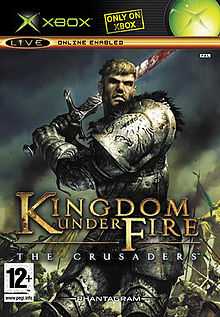Kingdom Under Fire: The Crusaders
| Kingdom Under Fire: The Crusaders | |
|---|---|
 | |
| Developer(s) | Phantagram |
| Publisher(s) |
|
| Platform(s) | Xbox |
| Release date(s) |
|
| Genre(s) | Hack and slash, Real-time tactics |
| Mode(s) | Single-player |
Kingdom Under Fire: The Crusaders is a tactical wargame developed by the Korean studio Phantagram for the Xbox. It is the sequel to the 2001 game Kingdom Under Fire: A War of Heroes, and continues its storyline. Kingdom Under Fire: The Crusaders combines third-person action and role-playing elements in its gameplay, which differs from its predecessor.
Its sequel is Kingdom Under Fire: Heroes. Another sequel is to be released in 2015 entitled Kingdom Under Fire II for PC and PlayStation 4.
Gameplay
The gameplay of Kingdom Under Fire: The Crusaders contains elements from the popular game Dynasty Warriors and aspects of various role-playing games. As well as controlling the main character, the player fights with multiple armies or "units", which are controlled in real-time with either a minimap or the main screen. When the main character's unit engages in mêlée with an enemy unit, the gameplay is similar to Dynasty Warriors.
Any unit in close-quarter combat cannot be used for anything else until the combat is resolved; an exception to this is when two units are in close-quarter combat with the enemy: one unit can retreat one unit whilst the other keeps the enemy unit occupied.
Units
The unit-types of the game include:
- Infantry: Engage units in melee.
- Archers: Fire at ground and air targets. Dark Legion archers may fire from horses and Ballistas can target air units as well
- Artillery: (catapults, mortars, ballistas) Engages units indirectly from a long range.
- Airborne units: Engages units from the air, where only archers, specially designed ballistas, and magic can attack them.
- Cavalry: May engage in melee combat, but are most effective when ordered to charge through troop formations.
- Sappers: Lays traps that serious damages enemy troops and can also set fire to forests. Can be used as a substitute for infantry. Pyrotechs for the Human Alliance may lay mines which causes more damage.
- Mortars: Functions just like archers with the exception to target air units but can take down castle walls. (Human Alliance only)
- Spearmen: Specialized troop which can take down enemy cavalry and immobilize troops in front of them. The Dark Legion version of spearmen are Orc Axemen
- Support Units: Units such as Storm Riders, Bomber Wings, Wyverns, Swamp Mammoths, and Dirigibles that can cause massive damage to the enemy.
- Scorpions: Huge living siege weapons that can take down castle walls and can be used as infantry. They are also invulnerable to arrows. (Dark Legion Exclusive)
- Orc Ghouls: Dead Orcs risen from the grave that have very high defense but are vulnerable to holy. Can send an Orc to self-destruct as a siege weapon. (Dark Legion Exclusive)
Combat magic
Besides normal combat, spells can be used in the battlefield. Most combat units can learn any kind of spell. Spells allow units to throw fireballs, call down meteors, heal the player's army, or send ghoulish suicide bombs to enemy forces.
The world
Kingdom Under Fire is set on the continent of Bersia, which is occupied by the following military powers:
- Ecclesia: A religious kingdom on the west coast of Bersia.
- Hironeiden: Another Human Kingdom south of Ecclesia.
- Azilia: A puppet kingdom controlled by Ecclesia.
- Arein: An elvish kingdom within Hironeiden.
- Vellond: The dark elf state ruled by half vampires.
- Hexter: A country full of orc and ogre tribes, commonwealth of Vellond.
Characters
- Human Alliance
- Gerald
- Main Weapon: One-handed sword
- Main Skill: Mêlée
- Kendal
- Main Weapon: Warhammer and mace
- Main Skill: Mêlée
- Walden
- Main Weapon: Sword and shield
- Main Skill: Mêlée
- Rupert
- Main Weapon: Two-Handed War Hammer
- Main Skill: Mêlée
- Ellen
- Main Weapon: Rapier and Bow
- Main Skill: Mêlée
- Sir Duane
- Main Weapon: Double Morning Stars
- Main Skill: Mêlée
- Thomas
- Main Weapon: Small Mace and Small Shield
- Main Skill: Mêlée
- Dark Legion
- Lucretia
- Main Weapon: Double Scimitars
- Main Skill: Mêlée
- Cirith
- Main Weapon: One Handed Sword
- Main Skill: Mêlée, Magic
- Rithrin
- Main Weapon: One-Handed Sword
- Main Skill: Mêlée
- Morene Strident
- Main Weapon: Two Bone Blades
- Main Skill: Mêlée
- Regnier
- Main Weapon: Greatsword
- Main Skill: Mêlée
- Leinhart
- Main Weapon:One Handed Scimitar
- Main Skill: Mêlée
- Urukubarr
- Main Weapon: Bare Hands
- Main Skill: Mêlée
Reviews
The game was very well received receiving an average scores of over 80% on aggregate, with few minor criticisms.[1]
References
- ↑ Sources:
- "Kingdom Under Fire: The Crusaders Critic Reviews for Xbox at Metacritic.com", www.metacritic.com (metacritic), retrieved 3 October 2011
- "Kingdom Under Fire: The Crusaders for Xbox - GameRankings", www.gamerankings.com (Game Rankings), retrieved 3 October 2011
External links
- "Kingdom Under Fire : The Crusaders", web.archive.org, archived from the original on 8 September 2008, official website
| ||||||||||